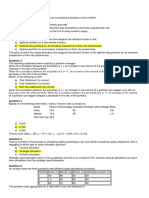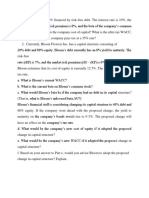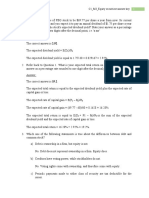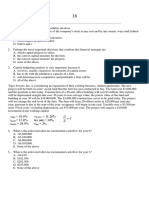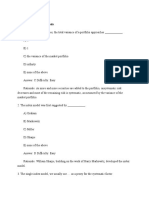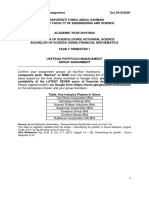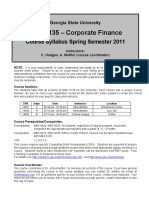Chap 008
Chap 008
Uploaded by
Ken WhiteCopyright:
Available Formats
Chap 008
Chap 008
Uploaded by
Ken WhiteCopyright
Available Formats
Share this document
Did you find this document useful?
Is this content inappropriate?
Copyright:
Available Formats
Chap 008
Chap 008
Uploaded by
Ken WhiteCopyright:
Available Formats
Chapter 8 Index Models
Multiple Choice Questions 1. As diversification increases, the total variance of a portfolio approaches ____________. A) 0 B) 1 C) the variance of the market portfolio D) infinity E) none of the above Answer: C Difficulty: Easy Rationale: As more and more securities are added to the portfolio, unsystematic risk decreases and most of the remaining risk is systematic, as measured by the variance of the market portfolio. 2. The index model was first suggested by ____________. A) Graham B) Markowitz C) Miller D) Sharpe E) none of the above Answer: D Difficulty: Easy Rationale: William Sharpe, building on the work of Harry Markowitz, developed the index model. 3. A single-index model uses __________ as a proxy for the systematic risk factor. A) a market index, such as the S&P 500 B) the current account deficit C) the growth rate in GNP D) the unemployment rate E) none of the above Answer: A Difficulty: Easy Rationale: The single-index model uses a market index, such as the S&P 500, as a proxy for the market, and thus for systematic risk.
163
4. The Security Risk Evaluation book published by Merrill Lynch relies on the __________ most recent monthly observations to calculate regression parameters. A) 12 B) 36 C) 60 D) 120 E) none of the above Answer: C Difficulty: Easy Rationale: Most published betas and other regression parameters, including those published by Merrill Lynch, are based on five years of monthly return data. 5. The Security Risk Evaluation book published by Merrill Lynch uses the __________ as a proxy for the market portfolio. A) Dow Jones Industrial Average B) Dow Jones Transportation Average C) S&P 500 Index D) Wilshire 5000 E) none of the above Answer: C Difficulty: Easy Rationale: The Merrill Lynch data (and much of the other published data sets) are based on the S&P 500 index as a market proxy. 6. According to the index model, covariances among security pairs are A) due to the influence of a single common factor represented by the market index return B) extremely difficult to calculate C) related to industry-specific events D) usually positive E) A and D Answer: E Difficulty: Easy Rationale: Most securities move together most of the time, and move with a market index, or market proxy.
Chapter 8 Index Models
7. The intercept calculated by Merrill Lynch in the regression equations is equal to A) in the CAPM B) + rf(1 + ) C) + rf(1 - ) D) 1 - E) none of the above Answer: C Difficulty: Moderate Rationale: The intercept that Merrill Lynch calls alpha is really, using the parameters of the CAPM, an estimate of a + rf (1 - b). The apparent justification for this procedure is that, on a monthly basis, rf(1 - b) is small and is apt to be swamped by the volatility of actual stock returns. 8. Analysts may use regression analysis to estimate the index model for a stock. When doing so, the slope of the regression line is an estimate of ______________. A) the of the asset B) the of the asset C) the of the asset D) the of the asset E) none of the above Answer: B Difficulty: Moderate Rationale: The slope of the regression line, b, measures the volatility of the stock versus the volatility of the market. 9. In a factor model, the return on a stock in a particular period will be related to _________. A) firm-specific events B) macroeconomic events C) the error term D) both A and B E) neither A nor B Answer: D Difficulty: Moderate Rationale: The return on a stock is related to both firm-specific and macroeconomic events.
165
10. Rosenberg and Guy found that __________ helped to predict a firm's beta. A) the firm's financial characteristics B) the firm's industry group C) firm size D) both A and B E) A, B and C all helped to predict betas. Answer: E Difficulty: Moderate Rationale: Rosenberg and Guy found that after controlling for the firm's financial characteristics, the firm's industry group was a significant predictor of the firm's beta. 11. If the index model is valid, _________ would be helpful in determining the covariance between assets K and L. A) k B) L C) M D) all of the above E) none of the above Answer: D Difficulty: Moderate Rationale: If the index model is valid A, B, and C are determinants of the covariance between K and L. 12. Rosenberg and Guy found that ___________ helped to predict firms' betas. A) debt/asset ratios B) market capitalization C) variance of earnings D) all of the above E) none of the above Answer: D Difficulty: Moderate Rationale: Rosenberg and Guy found that A, B, and C were determinants of firms' betas.
Chapter 8 Index Models
13. If a firm's beta was calculated as 0.6 in a regression equation, Merrill Lynch would state the adjusted beta at a number A) less than 0.6 but greater than zero. B) between 0.6 and 1.0. C) between 1.0 and 1.6. D) greater than 1.6. E) zero or less. Answer: B Difficulty: Moderate Rationale: Betas, on average, equal one; thus, betas over time regress toward the mean, or 1. Therefore, if historic betas are less than 1, adjusted betas are between 1 and the calculated beta. 14. The beta of Exxon stock has been estimated as 1.2 by Merrill Lynch using regression analysis on a sample of historical returns. The Merrill Lynch adjusted beta of Exxon stock would be ___________. A) 1.20 B) 1.32 C) 1.13 D) 1.0 E) none of the above Answer: C Difficulty: Moderate Rationale: Adjusted beta = 2/3 sample beta + 1/3(1); = 2/3(1.2) + 1/3 = 1.13. 15. Assume that stock market returns do not resemble a single-index structure. An investment fund analyzes 100 stocks in order to construct a mean-variance efficient portfolio constrained by 100 investments. They will need to calculate _____________ expected returns and ___________ variances of returns. A) 100, 100 B) 100, 4950 C) 4950, 100 D) 4950, 4950 E) none of the above Answer: A Difficulty: Moderate Rationale: The expected returns of each of the 100 securities must be calculated. In addition, the 100 variances around these returns must be calculated.
167
16. Assume that stock market returns do not resemble a single-index structure. An investment fund analyzes 100 stocks in order to construct a mean-variance efficient portfolio constrained by 100 investments. They will need to calculate ____________ covariances. A) 45 B) 100 C) 4,950 D) 10,000 E) none of the above Answer: C Difficulty: Moderate Rationale: (n2 - n)/2 = (10,000 - 100)/2 = 4,950 covariances must be calculated. 17. Assume that stock market returns do follow a single-index structure. An investment fund analyzes 200 stocks in order to construct a mean-variance efficient portfolio constrained by 200 investments. They will need to calculate ________ estimates of expected returns and ________ estimates of sensitivity coefficients to the macroeconomic factor. A) 200; 19,900 B) 200; 200 C) 19,900; 200 D) 19,900; 19.900 E) none of the above Answer: B Difficulty: Moderate Rationale: For a single-index model, n(200), expected returns and n(200) sensitivity coefficients to the macroeconomic factor must be estimated. 18. Assume that stock market returns do follow a single-index structure. An investment fund analyzes 500 stocks in order to construct a mean-variance efficient portfolio constrained by 500 investments. They will need to calculate ________ estimates of firm-specific variances and ________ estimates for the variance of the macroeconomic factor. A) 500; 1 B) 500; 500 C) 124,750; 1 D) 124,750; 500 E) 250,000; 500 Answer: A Difficulty: Moderate Rationale: For the single-index model, n(500) estimates of firm-specific variances must be calculated and 1 estimate for the variance of the common macroeconomic factor.
Chapter 8 Index Models
19. Consider the single-index model. The alpha of a stock is 0%. The return on the market index is 16%. The risk-free rate of return is 5%. The stock earns a return that exceeds the risk-free rate by 11% and there are no firmspecific events affecting the stock performance. The of the stock is _______. A) 0.67 B) 0.75 C) 1.0 D) 1.33 E) 1.50 Answer: C Difficulty: Moderate Rationale: 11% = 0% + b(11%); b = 1.0. 20. Suppose you held a well-diversified portfolio with a very large number of securities, and that the single index model holds. If the of your portfolio was 0.20 and M was 0.16, the of the portfolio would be approximately ________. A) 0.64 B) 0.80 C) 1.25 D) 1.56 E) none of the above Answer: C Difficulty: Difficult Rationale: s2p / s2m = b2; (0.2)2/(0.16)2 = 1.56; b = 1.25. 21. Suppose the following equation best describes the evolution of over time: t = 0.25 + 0.75t-1 If a stock had a of 0.6 last year, you would forecast the to be _______ in the coming year. A) 0.45 B) 0.60 C) 0.70 D) 0.75 E) none of the above Answer: C Difficulty: Easy Rationale: 0.25 + 0.75(0.6) = 0.70.
169
22. Merrill Lynch estimates the index model for a stock using regression analysis involving total returns. They estimated the intercept in the regression equation at 6% and the at 0.5. The risk-free rate of return is 12%. The true of the stock is ________. A) 0% B) 3% C) 6% D) 9% E) none of the above Answer: A Difficulty: Difficult Rationale: 6% = a + 12% (1 - 0.5); a = 0%. 23. The index model for stock A has been estimated with the following result: RA = 0.01 + 0.9RM + eA If M = 0.25 and R2A = 0.25, the standard deviation of return of stock A is _________. A) 0.2025 B) 0.2500 C) 0.4500 D) 0.8100 E) none of the above Answer: C Difficulty: Difficult Rationale: R2 = b2s2M / s2;0.25 = [(0.81)(0.25)2]/s2; s = 0.4500. 24. The index model for stock B has been estimated with the following result: RB = 0.01 + 1.1RM + eB If M = 0.20 and R2B = 0.50, the standard deviation of the return on stock B is _________. A) 0.1111 B) 0.2111 C) 0.3111 D) 0.4111 E) none of the above Answer: C Difficulty: Difficult Rationale: R2 = b2s2M / s2; 0.5 = [(1.1)2(0.2)2]/s2; s = 0.3111.
Chapter 8 Index Models
25. Suppose you forecast that the market index will earn a return of 15% in the coming year. Treasury bills are yielding 6%. The unadjusted of Mobil stock is 1.30. A reasonable forecast of the return on Mobil stock for the coming year is _________ if you use Merrill Lynch adjusted betas. A) 15.0% B) 15.5% C) 16.0% D) 16.8% E) none of the above Answer: D Difficulty: Difficult Rationale: Adjusted beta = 2/3(1.3) + 1/3 = 1.20; E(rM) = 6% + 1.20(9%) = 16.8%. 26. The index model has been estimated for stocks A and B with the following results: RA = 0.01 + 0.5RM + eA RB = 0.02 + 1.3RM + eB M = 0.25 (eA) = 0.20 (eB) = 0.10 The covariance between the returns on stocks A and B is ___________. A) 0.0384 B) 0.0406 C) 0.1920 D) 0.0050 E) 0.4000 Answer: B Difficulty: Difficult Rationale: Cov(RA,RB) = bAbBs2M = 0.5(1.3)(0.25)2 = 0.0406.
171
27. The index model has been estimated for stocks A and B with the following results: RA = 0.01 + 0.8RM + eA RB = 0.02 + 1.2RM + eB M = 0.20 (eA) = 0.20 (eB) = 0.10 The standard deviation for stock A is __________. A) 0.0656 B) 0.0676 C) 0.2561 D) 0.2600 E) none of the above Answer: C Difficulty: Difficult Rationale: A = [(0.8)2(0.2)2 + (0.2)2]1/2 = 0.2561. 28. The index model has been estimated for stock A with the following results: RA = 0.01 + 0.8RM + eA M = 0.20 (eA) = 0.10 The standard deviation of the return for stock A is __________. A) 0.0356 B) 0.1886 C) 0.1600 D) 0.6400 E) none of the above Answer: B Difficulty: Difficult Rationale: B = [(.8)2(0.2)2 + (0.1)2]1/2 = 0.1886. 29. Security returns A) are based on both macro events and firm-specific events. B) are based on firm-specific events only. C) are usually positively correlated with each other. D) A and B. E) A and C. Answer: E Difficulty: Easy Rationale: Stock returns are usually highly positively correlated with each other. Stock returns are affected by both macro economic events and firm-specific events.
Chapter 8 Index Models
30. The single-index model A) greatly reduces the number of required calculations, relative to those required by the Markowitz model. B) enhances the understanding of systematic versus nonsystematic risk. C) greatly increases the number of required calculations, relative to those required by the Markowitz model. D) A and B. E) B and C. Answer: D Difficulty: Easy Rationale: The single index model both greatly reduces the number of calculations and enhances the understanding of the relationship between systematic and unsystematic risk on security returns. 31. The Security Characteristic Line (SCL) A) plots the excess return on a security as a function of the excess return on the market. B) allows one to estimate the beta of the security. C) allows one to estimate the alpha of the security. D) all of the above. E) none of the above. Answer: D Difficulty: Easy Rationale: The security characteristic line, which plots the excess return of the security as a function of the excess return of the market allows one to estimate both the alpha and the beta of the security. 32. The expected impact of unanticipated macroeconomic events on a security's return during the period is A) included in the security's expected return. B) zero. C) equal to the risk free rate. D) proportional to the firm's beta. E) infinite. Answer: B Difficulty: Moderate Rationale: The expected value of unanticipated macroeconomic events is zero, because by definition it must average to zero or it would be incorporated into the expected return.
173
33. Covariances between security returns tend to be A) positive because of SEC regulations. B) positive because of Exchange regulations. C) positive because of economic forces that affect many firms. D) negative because of SEC regulations E) negative because of economic forces that affect many firms. Answer: C Difficulty: Moderate Rationale: Economic forces such as business cycles, interest rates, and technological changes tend to have similar impacts on many firms. 34. In the single-index model represented by the equation ri = E(ri) + iF + ei, the term ei represents A) the impact of unanticipated macroeconomic events on security i's return. B) the impact of unanticipated firm-specific events on security i's return. C) the impact of anticipated macroeconomic events on security i's return. D) the impact of anticipated firm-specific events on security i's return. E) the impact of changes in the market on security i's return. Answer: B Difficulty: Moderate Rationale: The textbook discusses a model in which macroeconomic events are used as a single index for security returns. The ei term represents the impact of unanticipated firm-specific events. The ei term has an expected value of zero. Only unanticipated events would affect the return. 35. Suppose you are doing a portfolio analysis that includes all of the stocks on the NYSE. Using a single-index model rather than the Markowitz model _______ the number of inputs needed from _______ to ________. A) increases, about 1,400, more than 1.4 million B) increases, about 10,000, more than 125,000 C) reduces, more than 125,000, about 10,000 D) reduces, more than 4 million, about 9,000 E) increases, about 150, more than 1,500 Answer: D Difficulty: Moderate Rationale: This example is discussed in the textbook. The main point for the students to remember is that the single-index model drastically reduces the number of inputs required.
Chapter 8 Index Models
36. One cost of the single-index model is that it A) is virtually impossible to apply. B) prohibits specialization of efforts within the security analysis industry. C) requires forecasts of the money supply. D) is legally prohibited by the SEC. E) allows for only two kinds of risk -- macro risk and micro risk. Answer: E Difficulty: Moderate Rationale: The single-index model discussed in chapter 10 broke risk into macro and micro portions. In this model other factors such as industry effects. 37. The Security Characteristic Line (SCL) associated with the single-index model is a plot of A) the security's returns on the vertical axis and the market index's returns on the horizontal axis. B) the market index's returns on the vertical axis and the security's returns on the horizontal axis. C) the security's excess returns on the vertical axis and the market index's excess returns on the horizontal axis. D) the market index's excess returns on the vertical axis and the security's excess returns on the horizontal axis. E) the security's returns on the vertical axis and Beta on the horizontal axis. Answer: C Difficulty: Moderate Rationale: The student needs to remember that it is the excess returns that are plotted and that the security's returns are plotted as a dependent variable. 38. The idea that there is a limit to the reduction of portfolio risk due to diversification is A) contradicted by both the CAPM and the single-index model. B) contradicted by the CAPM. C) contradicted by the single-index model. D) supported in theory, but not supported empirically. E) supported both in theory and by empirical evidence. Answer: E Difficulty: Moderate Rationale: The benefits of diversification are limited to the level of systematic risk. Figure 8.1 shows this concept graphically.
175
39. In their study about predicting beta coefficients, which of the following did Rosenberg and Guy find to be factors that influence beta? I) II) III) IV) A) B) C) D) E) industry group variance of cash flow dividend yield growth in earnings per share
I and II I and III I, II, and III I, II, and IV I, II, III, and IV
Answer: E Difficulty: Moderate Rationale: All of the factors mentioned, as well as variance of earnings, firm size, and debt-to-asset ratio, were found to help predict betas. 40. If a firm's beta was calculated as 1.6 in a regression equation, Merrill Lynch would state the adjusted beta at a number A) less than 0.6 but greater than zero. B) between 0.6 and 1.0. C) between 1.0 and 1.6. D) greater than 1.6. E) zero or less. Answer: C Difficulty: Moderate Rationale: Betas, on average, equal one; thus, betas over time regress toward the mean, or 1. Therefore, if historic betas are more than 1, adjusted betas are between 1 and the calculated beta. 41. The beta of a stock has been estimated as 1.8 by Merrill Lynch using regression analysis on a sample of historical returns. The Merrill Lynch adjusted beta of the stock would be ___________. A) 1.20 B) 1.53 C) 1.13 D) 1.0 E) none of the above Answer: B Difficulty: Moderate Rationale: Adjusted beta = 2/3 sample beta + 1/3(1); = 2/3(1.8) + 1/3 = 1.53.
Chapter 8 Index Models
42. Assume that stock market returns do not resemble a single-index structure. An investment fund analyzes 40 stocks in order to construct a mean-variance efficient portfolio constrained by 40 investments. They will need to calculate _____________ expected returns and ___________ variances of returns. A) 100, 100 B) 40, 40 C) 4950, 100 D) 4950, 4950 E) none of the above Answer: B Difficulty: Moderate Rationale: The expected returns of each of the 40 securities must be calculated. In addition, the 40 variances around these returns must be calculated. 43. Assume that stock market returns do not resemble a single-index structure. An investment fund analyzes 40 stocks in order to construct a mean-variance efficient portfolio constrained by 40 investments. They will need to calculate ____________ covariances. A) 45 B) 780 C) 4,950 D) 10,000 E) none of the above Answer: B Difficulty: Moderate Rationale: (n2 - n)/2 = (1,600 - 40)/2 = 780 covariances must be calculated. 44. Assume that stock market returns do follow a single-index structure. An investment fund analyzes 60 stocks in order to construct a mean-variance efficient portfolio constrained by 60 investments. They will need to calculate ________ estimates of expected returns and ________ estimates of sensitivity coefficients to the macroeconomic factor. A) 200; 19,900 B) 200; 200 C) 60; 60 D) 19,900; 19.900 E) none of the above Answer: C Difficulty: Moderate Rationale: For a single-index model, n(60), expected returns and n(60) sensitivity coefficients to the macroeconomic factor must be estimated.
177
45. Consider the single-index model. The alpha of a stock is 0%. The return on the market index is 10%. The risk-free rate of return is 3%. The stock earns a return that exceeds the risk-free rate by 11% and there are no firm-specific events affecting the stock performance. The of the stock is _______. A) 0.64 B) 0.75 C) 1.17 D) 1.33 E) 1.50 Answer: A Difficulty: Moderate Rationale: 7% = 0% + b(11%); b = 0.636. 46. Suppose you held a well-diversified portfolio with a very large number of securities, and that the single index model holds. If the of your portfolio was 0.25 and M was 0.21, the of the portfolio would be approximately ________. A) 0.64 B) 1.19 C) 1.25 D) 1.56 E) none of the above Answer: B Difficulty: Difficult Rationale: s2p / s2m = b2; (0.25)2/(0.21)2 = 1.417; b = 1.19. 47. Suppose you held a well-diversified portfolio with a very large number of securities, and that the single index model holds. If the of your portfolio was 0.18 and M was 0.22, the of the portfolio would be approximately ________. A) 0.64 B) 1.19 C) 0.82 D) 1.56 E) none of the above Answer: C Difficulty: Difficult Rationale: s2p / s2m = b2; (0.18)2/(0.22)2 = 0.669; b = 0.82.
Chapter 8 Index Models
48. Suppose the following equation best describes the evolution of over time: t = 0.4 + 0.6t-1 If a stock had a of 0.9 last year, you would forecast the to be _______ in the coming year. A) 0.45 B) 0.60 C) 0.70 D) 0.94 E) none of the above Answer: D Difficulty: Easy Rationale: 0.4 + 0.6(0.9) = 0.94. 49. Suppose the following equation best describes the evolution of over time: t = 0.3 + 0.2t-1 If a stock had a of 0.8 last year, you would forecast the to be _______ in the coming year. A) 0.46 B) 0.60 C) 0.70 D) 0.94 E) none of the above Answer: A Difficulty: Easy Rationale: 0.3 + 0.2(0.8) = 0.46. 50. The index model for stock A has been estimated with the following result: RA = 0.01 + 0.94RM + eA If M = 0.30 and R2A = 0.28, the standard deviation of return of stock A is _________. A) 0.2025 B) 0.2500 C) 0.4500 D) 0.5329 E) none of the above Answer: D Difficulty: Difficult
179
Rationale: R2 = b2s2M / s2; 0.28 = [(0.94) 2(0.30) 2] / .28; s = 0.5329.
Chapter 8 Index Models
51. 30. A reasonable forecast of the return on Mobil stock for the coming year is _________ if you use Merrill Lynch adjusted betas. A) 15.0% B) 15.5% C) 16.0% D) 14.6% E) none of the above Answer: D Difficulty: Difficult Rationale: Adjusted beta = 2/3(1.5) + 1/3 = 1.33; E(rM) = 4% + 1.33(8%) = 14.6%. 52. The index model has been estimated for stocks A and B with the following results: RA = 0.01 + 0.8RM + eA RB = 0.02 + 1.1RM + eB M = 0.30 (eA) = 0.20 (eB) = 0.10 The covariance between the returns on stocks A and B is ___________. A) 0.0384 B) 0.0406 C) 0.1920 D) 0.0050 E) 0.0792 Answer: E Difficulty: Difficult Rationale: Cov(RA,RB) = bAbBs2M = 0.8(1.1)(0.30)2 = 0.0792. 53. If a firm's beta was calculated as 1.35 in a regression equation, Merrill Lynch would state the adjusted beta at a number A) less than 1.35 B) between 0.0 and 1.0. C) between 1.0 and 1.35. D) greater than 1.35. E) zero or less. Answer: C Difficulty: Moderate Rationale: Betas, on average, equal one; thus, betas over time regress toward the mean, or 1. Therefore, if historic betas are less than 1, adjusted betas are between 1 and the calculated beta.
181
54. The beta of a stock has been estimated as 1.4 by Merrill Lynch using regression analysis on a sample of historical returns. The Merrill Lynch adjusted beta of the stock would be ___________. A) 1.27 B) 1.32 C) 1.13 D) 1.0 E) none of the above Answer: A Difficulty: Moderate Rationale: Adjusted beta = 2/3 sample beta + 1/3(1); = 2/3(1.4) + 1/3 = 1.27. 55. The beta of a stock has been estimated as 0.85 by Merrill Lynch using regression analysis on a sample of historical returns. The Merrill Lynch adjusted beta of the stock would be ___________. A) 1.01 B) 0.95 C) 1.13 D) 0.90 E) none of the above Answer: D Difficulty: Moderate Rationale: Adjusted beta = 2/3 sample beta + 1/3(1); = 2/3(0.85) + 1/3 = 0.90. 56. Assume that stock market returns do not resemble a single-index structure. An investment fund analyzes 125 stocks in order to construct a mean-variance efficient portfolio constrained by 125 investments. They will need to calculate _____________ expected returns and ___________ variances of returns. A) 125, 125 B) 125, 15,625 C) 15,625, 125 D) 15,625, 15,625 E) none of the above Answer: A Difficulty: Moderate Rationale: The expected returns of each of the 125 securities must be calculated. In addition, the 125 variances around these returns must be calculated.
Chapter 8 Index Models
57. Assume that stock market returns do not resemble a single-index structure. An investment fund analyzes 125 stocks in order to construct a mean-variance efficient portfolio constrained by 125 investments. They will need to calculate ____________ covariances. A) 90 B) 125 C) 7,750 D) 15,625 E) none of the above Answer: C Difficulty: Moderate Rationale: (n2 - n)/2 = (15,625 - 125)/2 = 7,750 covariances must be calculated. 58. Assume that stock market returns do not resemble a single-index structure. An investment fund analyzes 132 stocks in order to construct a mean-variance efficient portfolio constrained by 132 investments. They will need to calculate ____________ covariances. A) 100 B) 132 C) 4,950 D) 8,646 E) none of the above Answer: D Difficulty: Moderate Rationale: (n2 - n)/2 = (17,424 - 132)/2 = 8,646 covariances must be calculated. 59. Assume that stock market returns do follow a single-index structure. An investment fund analyzes 217 stocks in order to construct a mean-variance efficient portfolio constrained by 217 investments. They will need to calculate ________ estimates of expected returns and ________ estimates of sensitivity coefficients to the macroeconomic factor. A) 217; 47,089 B) 217; 217 C) 47,089; 217 D) 47,089; 47,089 E) none of the above Answer: B Difficulty: Moderate Rationale: For a single-index model, n(217), expected returns and n(217) sensitivity coefficients to the macroeconomic factor must be estimated.
183
60. Assume that stock market returns do follow a single-index structure. An investment fund analyzes 500 stocks in order to construct a mean-variance efficient portfolio constrained by 750 investments. They will need to calculate ________ estimates of firm-specific variances and ________ estimates for the variance of the macroeconomic factor. A) 750; 1 B) 750; 750 C) 124,750; 1 D) 124,750; 750 E) 562,500; 750 Answer: A Difficulty: Moderate Rationale: For the single-index model, n(750) estimates of firm-specific variances must be calculated and 1 estimate for the variance of the common macroeconomic factor. 61. Consider the single-index model. The alpha of a stock is 0%. The return on the market index is 10%. The risk-free rate of return is 5%. The stock earns a return that exceeds the risk-free rate by 5% and there are no firm-specific events affecting the stock performance. The of the stock is _______. A) 0.67 B) 0.75 C) 1.0 D) 1.33 E) 1.50 Answer: C Difficulty: Moderate Rationale: 5% = 0% + b(5%); b = 1.0. 62. Suppose you held a well-diversified portfolio with a very large number of securities, and that the single index model holds. If the of your portfolio was 0.24 and M was 0.18, the of the portfolio would be approximately ________. A) 0.64 B) 1.33 C) 1.25 D) 1.56 E) none of the above Answer: B Difficulty: Difficult Rationale: s2p / s2m = b2; (0.24)2/(0.18)2 = 1.78; b = 1.33.
Chapter 8 Index Models
63. Suppose you held a well-diversified portfolio with a very large number of securities, and that the single index model holds. If the of your portfolio was 0.14 and M was 0.19, the of the portfolio would be approximately ________. A) 0.74 B) 0.80 C) 1.25 D) 1.56 E) none of the above Answer: A Difficulty: Difficult Rationale: s2p / s2m = b2; (0.14)2/(0.19)2 = 0.54; b = 0.74. 64. Suppose the following equation best describes the evolution of over time: t = 0.30 + 0.70t-1 If a stock had a of 0.82 last year, you would forecast the to be _______ in the coming year. A) 0.91 B) 0.77 C) 0.63 D) 0.87 E) none of the above Answer: D Difficulty: Easy Rationale: 0.30 + 0.70(0.82) = 0.874. 65. The index model has been estimated for stocks A and B with the following results: RA = 0.03 + 0.7RM + eA RB = 0.01 + 0.9RM + eB M = 0.35 (eA) = 0.20 (eB) = 0.10 The covariance between the returns on stocks A and B is ___________. A) 0.0384 B) 0.0406 C) 0.1920 D) 0.0772 E) 0.4000 Answer: D Difficulty: Difficult
185
Rationale: Cov(RA,RB) = bAbBs2M = 0.7(0.9)(0.35)2 = 0.0772.
Chapter 8 Index Models
Essay Questions 66. Discuss the advantages of the single-index model over the Markowitz model in terms of numbers of variable estimates required and in terms of understanding risk relationships. Difficulty: Moderate Answer: For a 50 security portfolio, the Markowitz model requires the following parameter estimates: n = 50 estimates of expected returns; n = 50 estimates of variances; (n2 - n)/2 = 1,225 estimates of covariances; 1,325 estimates. For a 50 security portfolio, the single-index model requires the following parameter estimates: n = 50 estimates of expected excess returns, E(R); n = 50 estimates of sensitivity coefficients, i; n = 50 estimates of the firm-specific variances, 2(ei); 1 estimate for the variance of the common macroeconomic factor, 2M; or (3n + 1) estimates. In addition, the single-index model provides further insight by recognizing that different firms have different sensitivities to macroeconomic events. The model also summarizes the distinction between macroeconomic and firm-specific risk factors. This question is designed to ascertain that the student understands the significant simplifications and improvements offered by the single-index model over the Markowitz model.
187
67. Discuss the security characteristic line (SCL). Difficulty: Moderate Answer: The security characteristic line (SCL) is the result of estimating the regression equation of the single-index model. The SCL is a plot of the typical excess returns on a security over the risk-free rate as a function of the excess return on the market. The slope of the SCL is the beta of the security, and they-intercept, alpha, is the excess return on the security when the excess market return is zero. This question is designed to ascertain that the student understands how the SCL is obtained, as this relationship is the one that is most frequently used by published information services for the estimation of the regression parameters, alpha and beta. 68. Discuss the "adjusted betas" published by Merrill Lynch in Security Risk Evaluation. Difficulty: Easy Answer: Over time, security betas move toward 1, as the average beta of all securities is 1 and variables regress toward the mean. Thus, if a historic beta has been greater than 1, the chances are that in the future, this beta will be less than the historic beta. The opposite relationship will be observed if the historic beta has been less than one. Merrill Lynch uses the following relationship to calculate "adjusted betas". Adjusted beta = 2/3 (sample beta) + 1/3 (1). This question is important, as many published sources quote an "adjusted beta" with no explanation as to how such a number was obtained. The regression toward the mean is a valid statistical concept and it is important that the student understands that this concept represents the theory behind the possibly undocumented "adjusted betas".
You might also like
- Cbus Corporate Super PDSDocument24 pagesCbus Corporate Super PDSravinder.lmhNo ratings yet
- Quantitative Equity Portfolio Management: An Active Approach to Portfolio Construction and ManagementFrom EverandQuantitative Equity Portfolio Management: An Active Approach to Portfolio Construction and ManagementRating: 4.5 out of 5 stars4.5/5 (2)
- Chapter 8 Multiple ChoiceDocument6 pagesChapter 8 Multiple ChoiceAlex 1110% (1)
- Jun18l1pma-C02 QaDocument4 pagesJun18l1pma-C02 Qarafav10No ratings yet
- Chapter 04 AnsDocument38 pagesChapter 04 AnsLuisLoNo ratings yet
- #1 - Midterm Self Evaluation SolutionsDocument6 pages#1 - Midterm Self Evaluation SolutionsDionizioNo ratings yet
- Chap008 A SOLDocument13 pagesChap008 A SOLKaif Mohammad HussainNo ratings yet
- Chap 019Document41 pagesChap 019Peggy LiewNo ratings yet
- Chap 7 End of Chap SolDocument13 pagesChap 7 End of Chap SolWan Chee100% (1)
- Chapter 05 Risk and Return Past and PrologueDocument30 pagesChapter 05 Risk and Return Past and PrologueThanh Lê0% (1)
- Fin622 Midterm Solved Paper Master File by Hafiz SalmanDocument211 pagesFin622 Midterm Solved Paper Master File by Hafiz SalmanShrgeel Hussain100% (1)
- The 5 Dollar A Day Investing Plan PDFDocument29 pagesThe 5 Dollar A Day Investing Plan PDFTapiwa100% (1)
- IapmDocument129 pagesIapmKomal BagrodiaNo ratings yet
- Capital Structure of Hindalco Industries LimitedDocument69 pagesCapital Structure of Hindalco Industries LimitedAmar Rajput0% (1)
- Chap 009Document24 pagesChap 009Hajrah AsifNo ratings yet
- Chap 012Document16 pagesChap 012Jeffrey MooketsaneNo ratings yet
- Chapter 05 AnsDocument42 pagesChapter 05 AnsLuisLoNo ratings yet
- Fsav 6e Test Bank Mod15 TF MC 102720Document21 pagesFsav 6e Test Bank Mod15 TF MC 102720pauline leNo ratings yet
- Chapter 8 Index ModelsDocument26 pagesChapter 8 Index Modelshakarappelz100% (1)
- Market Risk and ReturnDocument3 pagesMarket Risk and ReturnruqayyadNo ratings yet
- Chap 06Document32 pagesChap 06Mihai StoicaNo ratings yet
- FIN352 FALL17Exam2Document6 pagesFIN352 FALL17Exam2Hiếu Nguyễn Minh Hoàng0% (1)
- Chap 017Document45 pagesChap 017saud1411No ratings yet
- TBChap 016Document79 pagesTBChap 016Kawser islam0% (1)
- Chap 006Document25 pagesChap 006Luqman AhmedNo ratings yet
- Chap 023Document42 pagesChap 023nobNo ratings yet
- 3 Review SP14 Chapters 6 and 7 WITH Solutions PDFDocument6 pages3 Review SP14 Chapters 6 and 7 WITH Solutions PDFJeff CagleNo ratings yet
- FINC3014 Topic 10 SolutionsDocument4 pagesFINC3014 Topic 10 Solutionssuitup100No ratings yet
- Chapter 07 Optimal Risky Portfolios: Answer KeyDocument44 pagesChapter 07 Optimal Risky Portfolios: Answer KeyLuisLoNo ratings yet
- Chap006 Text BankDocument9 pagesChap006 Text BankPratik JainNo ratings yet
- Investments Test 4 Study Guide (11-14)Document23 pagesInvestments Test 4 Study Guide (11-14)Lauren100% (2)
- Chapter 5 - Time Value of Money-Student VersionDocument8 pagesChapter 5 - Time Value of Money-Student Versionnamle999101No ratings yet
- CH 1Document81 pagesCH 1Michael FineNo ratings yet
- Lecture Notes For Chapter 13Document34 pagesLecture Notes For Chapter 13Raazia ImranNo ratings yet
- Final Exam Questions Portfolio ManagementDocument9 pagesFinal Exam Questions Portfolio ManagementThảo Như Trần NgọcNo ratings yet
- Chap 016Document32 pagesChap 016armailgmNo ratings yet
- Chapter 07Document34 pagesChapter 07Lea WehbeNo ratings yet
- Chapter 22Document76 pagesChapter 22Olivia SunNo ratings yet
- CONFUSEDDocument1 pageCONFUSEDLâm Thanh Huyền NguyễnNo ratings yet
- CH 9Document82 pagesCH 9Michael Fine100% (2)
- Chapter 16Document7 pagesChapter 16britt1611No ratings yet
- 8 Edit Finance Corporate FinanceDocument101 pages8 Edit Finance Corporate FinanceKhail Gooding0% (2)
- Wacc QuestionsDocument5 pagesWacc Questionsmuhammad farhanNo ratings yet
- Financial Service ManagementDocument38 pagesFinancial Service Managementsolid9283No ratings yet
- Chap 008Document43 pagesChap 008saud1411100% (6)
- Multiple Choice Questions Please Circle The Correct Answer There Is Only One Correct Answer Per QuestionDocument39 pagesMultiple Choice Questions Please Circle The Correct Answer There Is Only One Correct Answer Per Questionquickreader12No ratings yet
- Efficient Capital Markets and Behavioral Challenges: Multiple Choice QuestionsDocument16 pagesEfficient Capital Markets and Behavioral Challenges: Multiple Choice QuestionsCông Long NguyễnNo ratings yet
- Equity Securities - Answer Key PDFDocument5 pagesEquity Securities - Answer Key PDFVikaNo ratings yet
- Chap 011Document48 pagesChap 011saud1411100% (3)
- Chapter 21 The Monetary Policy and Aggregate Demand CurvesDocument7 pagesChapter 21 The Monetary Policy and Aggregate Demand CurvesserbannerNo ratings yet
- Chapter 6: Risk Aversion and Capital Allocation To Risky AssetsDocument14 pagesChapter 6: Risk Aversion and Capital Allocation To Risky AssetsNatalie OngNo ratings yet
- Chapter 09 Foreign Currency Transactions and Hedging Foreign Exchange RiskDocument31 pagesChapter 09 Foreign Currency Transactions and Hedging Foreign Exchange Riskunknown100% (1)
- MAS III Review Question PrelimDocument17 pagesMAS III Review Question PrelimJana LingcayNo ratings yet
- Stocks and Their Valuation: Multiple Choice: ConceptualDocument2 pagesStocks and Their Valuation: Multiple Choice: ConceptualKristel SumabatNo ratings yet
- Chapter Six: Risk and Risk Aversion: Study Notes of Bodie, Kane & Marcus by Zhipeng YanDocument24 pagesChapter Six: Risk and Risk Aversion: Study Notes of Bodie, Kane & Marcus by Zhipeng YanOblivionOmbreNo ratings yet
- CH 06Document13 pagesCH 06Efrén Barreto100% (1)
- FIM Question Practice 2Document15 pagesFIM Question Practice 2Bao Khanh HaNo ratings yet
- Chapter 008 Stock Valuation: Aacsb Topic: Analytic SECTION: 8.1 Topic: Stock Value Type: ProblemsDocument23 pagesChapter 008 Stock Valuation: Aacsb Topic: Analytic SECTION: 8.1 Topic: Stock Value Type: Problemsdarling assylaNo ratings yet
- Finc600 Week 4 Practice QuizDocument5 pagesFinc600 Week 4 Practice QuizDonald112100% (3)
- StudentDocument33 pagesStudentKevin Che100% (2)
- Financial Instruments and Institutions: Accounting and Disclosure RulesFrom EverandFinancial Instruments and Institutions: Accounting and Disclosure RulesNo ratings yet
- Investment (Index Model)Document29 pagesInvestment (Index Model)Quoc Anh NguyenNo ratings yet
- Chap 08Document36 pagesChap 08George MartinNo ratings yet
- P1.T3. Financial Markets & Products Bionic Turtle FRM Practice Questions Chapter 9. Foreign Exchange MarketsDocument25 pagesP1.T3. Financial Markets & Products Bionic Turtle FRM Practice Questions Chapter 9. Foreign Exchange MarketsChristian Rey MagtibayNo ratings yet
- Business Plan: Ganga Mineral Water PlantDocument18 pagesBusiness Plan: Ganga Mineral Water Plantarun1q100% (1)
- Chilime Hydropower ProjectDocument24 pagesChilime Hydropower ProjectChaudhari Awadhesh67% (3)
- Module 4 Sources of Finance Handouts For LMS 2020Document45 pagesModule 4 Sources of Finance Handouts For LMS 2020sandeshNo ratings yet
- Advanced Ms Excel ManualDocument51 pagesAdvanced Ms Excel ManualMohamed Hussain100% (4)
- ShoaibDocument2 pagesShoaibAxam FareedNo ratings yet
- How To Value Stocks - Part 1Document6 pagesHow To Value Stocks - Part 1vurublog100% (1)
- Group Assignment Ukff3283 201910Document12 pagesGroup Assignment Ukff3283 201910Jayden YapNo ratings yet
- B.inggris N Kel.2Document34 pagesB.inggris N Kel.2Putra RakhmadaniNo ratings yet
- Calculating An Annuity: Total Principal × (1 + Rate)Document23 pagesCalculating An Annuity: Total Principal × (1 + Rate)Prince AdyNo ratings yet
- Alaska For Upload - Free EssayDocument23 pagesAlaska For Upload - Free Essaysophie_irishNo ratings yet
- FM Assignment 2 FinalDocument10 pagesFM Assignment 2 Finalkj0850226No ratings yet
- NZ Tax IndividualDocument60 pagesNZ Tax IndividualSusana SembranoNo ratings yet
- Valuing Contingent Consideration Using Option Pricing PDFDocument16 pagesValuing Contingent Consideration Using Option Pricing PDFOmer LandauNo ratings yet
- Chapter-1 Return and RiskDocument11 pagesChapter-1 Return and RiskAndualem ZenebeNo ratings yet
- Investment ProposalDocument17 pagesInvestment ProposalTẤN LỘC LouisNo ratings yet
- P1 Question May 2022Document6 pagesP1 Question May 2022S.M.A AwalNo ratings yet
- Financial Statement Analysis of Kohat Cement Company LimitedDocument67 pagesFinancial Statement Analysis of Kohat Cement Company LimitedMuhammad Abdullah100% (3)
- 5 Nominal and Effective Interest Rates RSDocument32 pages5 Nominal and Effective Interest Rates RSAkshat PradhanNo ratings yet
- Accountancy Project On ITC - 20241120 - 120719 - 0000Document45 pagesAccountancy Project On ITC - 20241120 - 120719 - 0000Prasoon100% (2)
- MBA711 - Answers To Book - Chapter 4Document16 pagesMBA711 - Answers To Book - Chapter 4Robert JansonNo ratings yet
- Financial Management: Deobela Fulo-Fortes, MPADocument41 pagesFinancial Management: Deobela Fulo-Fortes, MPAAxel MendozaNo ratings yet
- Time Value of Money: Future Value Present Value Annuities Rates of Return AmortizationDocument55 pagesTime Value of Money: Future Value Present Value Annuities Rates of Return Amortizationfaheem qureshiNo ratings yet
- Business Performance Analysis Report ExampleDocument28 pagesBusiness Performance Analysis Report ExampleMac TinhNo ratings yet
- MBA 8135 - Corporate Finance: Course Syllabus Spring Semester 2011Document8 pagesMBA 8135 - Corporate Finance: Course Syllabus Spring Semester 2011lilbouyinNo ratings yet



